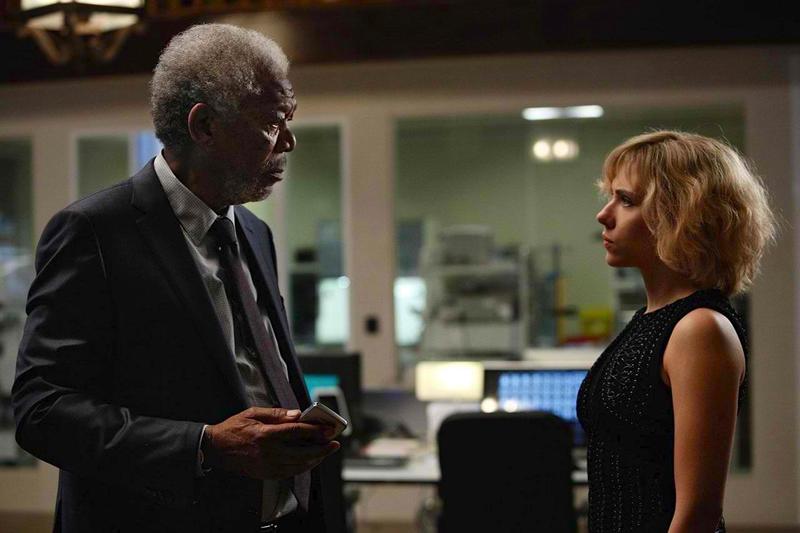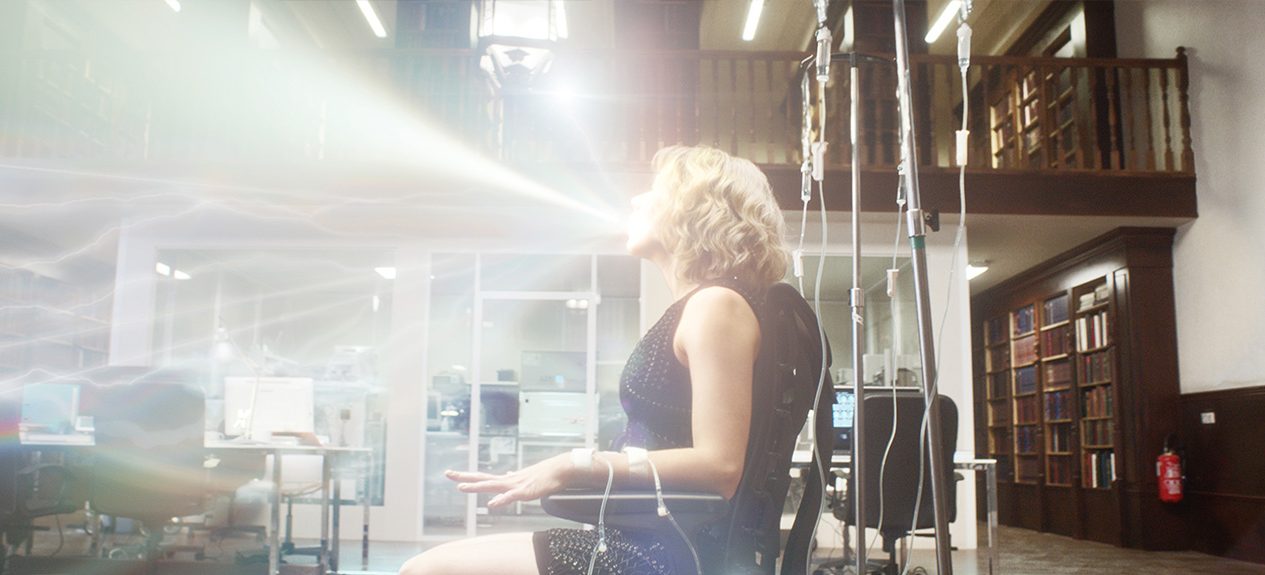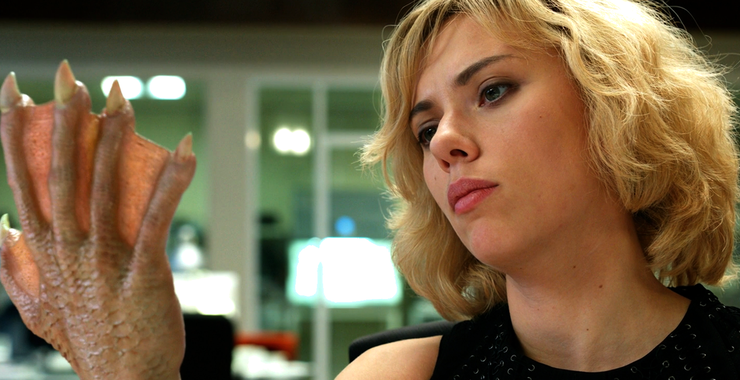Lucy is one of the more intriguing, psychedelic blockbusters of the 21st century. Riding the coattails of 2011’s Limitless (the Bradley Cooper vehicle about a man who stumbles upon a pill that allows him to use 100% of his brain capacity), Lucy explores the hypothetical fantasy of an individual actualizing untapped cognitive superpowers. Helmed by Luc Bresson, the film blends gangster/shoot-’em-up genre signifiers with sci-fi semiotics to achieve a unique effect: visualizing humanity’s synaptic fabric at its utmost potentiality, both theoretically and fictively.
The focal point of the film is Lucy (Scarlet Johansson), who is taken captive and coerced to serve as the drug mule for CPH4: a rare, mind-enhancing, and extremely valuable synthetic drug. After being surgically implanted with CPH4 (supposedly derived from the chemical produced during natal gestation period), the chemical packaging accidentally breaks, leaking into her bloodstream. Steadily secreted with high amounts of CPH4, Lucy soon begins to tap into incredibly dynamic sublayers of her cognitive topography, acquiring the powers of telekinesis and telepathy. There’s a kick, of course—her boosted mental dexterity comes at the cost of accelerating her metabolic/cellular putrescence.
It’s a classic, Faustian situation: a trade-off between virtuosity and longevity, cellular prowess and near-instantaneous senescence. Intoxicated by her new power, Lucy naturally evolves to perceive the world through newfound eyes. She finds herself preoccupied with immortality instead of balance or reproduction—after all, she’s leapt beyond the averageness of our basic, parabolic metabolism and catapulted into a vertically ascendant neural trajectory. Her ontology quickly becomes supersonic, even astral perhaps—Lucy is reborn into a psychonaut hellbent on transcendent self-realization.
Thins quickly become quite recondite. Luckily, we have Professor Norman (Morgan Freeman) providing us with large doses of supplemental exposition—guiding the audience along by feeding the plot’s logic as any scientist role in a ’90s disaster movie might. Early on, Norman details Lucy’s neurological development stage by stage—spoon-feeding digestible summaries of each incremental increase of Lucy’s brain functioning, sensory awareness, and cellular profundity. He posits, in Darwinian-deduced logic, that all species tend to seek ways of reproduction once a minimum degree of security is achieved. In Lucy’s case, this scenario becomes true in novel, neurological fashion. Instead of holding the conventional maternal inclination to procreate via the womb, Lucy finds herself obsessed with propagating her genetic composition via consciousness. Confronted with both cellular instability and impending mortality, her genetic proclivity is to externalize her mind—to reproduce her neural-DNA via the pursuit of immortality.

Johansson is perfectly fit to play this conflicted role: simultaneously cerebral and maternal, intellectual and sensual, fierce and gentle, she naturally personifies the central tensions and dichotomies at play. Her personal growth as Lucy is never less than fascinating on a evolutionary plane. Despite being a victim, she quickly adopts her new neurochemical disposition—proving that our preoccupations are possible more determined by hormonal/psychological calibrations than we may believe. In other words, Lucy is a prime example of that belief that are ideological leanings are flimsily encoded, and deeply contextual. Before long, she repudiates her more mediocre humanly preoccupations, finding herself ever more obsessed with her Neophyte trajectory. Intoxicated by power and possibility, she seemingly accepts the quest to become a pan-conscious, neuroplastic Übermensch.
In one of the film’s most daring and spellbinding sequences, Lucy recalls memories and sensations deeply embedded within her body. Suddenly, she can summon experiences dating back to the womb—remembering the taste of her mother’s breast milk, the sounds and pains of her young tendons and joints growing as a child, and so on. Cosmically attuned, Lucy is beginning to exceed her previous entrapment to immediate experiences. Moreover, her retrospective versatility goes way beyond basic nostalgia of remembrance. She viscerally reincarnates the past: merging the boundaries of ideas and flesh. She has fully transitioned into the inchoate stages of a new psychic dimension—unfettered from the routine thresholds of ordinary human immanence.
At this juncture in Lucy’s mutation, emotions (fear, sadness, love) begin to dissipate, or blur, into purely temporal elements. Affect, in both the film’s narrative and visual language, becomes increasingly kinetic—sheer velocity. As Lucy speeds toward new hyperactive planes on the cognitive continuum, she begins to bend, warp, and control the increasingly malleable frequencies of her universe. As manifested by Luc Bresson in breathtaking sequences, we witness Lucy traversing a metropolitan cityscape that is dynamically alive. The urban space is teeming and proliferating with information/data. It has become a synesthetic, multivalent frontier—apparently, her consciousness is now capable of rearranging the fundamental molecularity of things simply by tapping into her neural nexus/circuitry.
Miraculously transformed into a veritable superhuman, Lucy becomes philosophically, evolutionarily, and cinematically synchronized. Like Spider-Man after the iconic spider bite, Lucy is reborn within her old skin—privately transformed into a fully-embodied mutant. However, unlike most lazily-defined superheroes, Lucy’s regeneration is primarily psychic—exponentially more metaphysical than sacrificial, heroic, or strength-based. She’s not fixated on saving citizens from runaway subway trains or safeguarding silly infinity stones. Sure, there’s a side plot with a squadron of drug smuggling thugs interwoven into the plot (so as to satisfy studio execs and offer a little summer blockbuster panache), but at its heart, Lucy is mostly concerned with pursuing neuroscientific questions.

To approximate the titular character’s genius and quantum entangling, Bresson propels the film’s visual language to a level of dazzling, kaleidoscopic celerity. Through Lucy’s eyes, we recurrently witness neon lines and dazzling fields of CGI-infused signals appear in public spheres like transubstantiated waves of string theory. At the sight of these extraordinary interfaces, we begin to intuit that Lucy’s intelligence is slowly segueing into a vessel of pure energy — barreling toward a climactic eschatology of cellular permeability & intellectual multiplicity. Lucy is becoming a techno-utopian fantasy—a holistic, globalized, porous network of disseminated ideation.
At the same time, Lucy is not solely interested in the boundary limits of consciousness—it’s also keen about deconstructing the ethical interstices between radical mutation and normative averageness. The notion of a super-human is organically loaded with connotations of egoism, perilous responsibility, lethal momentum. Similarly, the moral issues that arise are more complex than simple pride/humility dualities. As Lucy gains the neural capacity to surpass the stultifying limitations of the routine mind (logic, emotion, morality), she finds herself prone to new quandaries—namely, the declining health & sense of identity/autonomy that naturally results from her hyperactive hormonal and cognitive reprogramming.
Lucy’s superabundant perspectival bandwidth is biologically and even psychologically self-defeating—overwhelmed with power, she organically becomes resolute upon fulfilling the prophecy of attaining psychic inter-dimensionality at the consequence of sentient nullity. Accordingly, the film wisely ruminates on the mortal and corporeal repercussions of sublimating oneself into a ethereal super-mind, implicitly posing countless philosophical inquiries:
- Will Lucy retain any agency once she’s fully externalized and enveloped into the cosmic/digital plenum?
- How does the body reconcile self-hood with boundlessness?
- Does the mind have the inherent power to make the universe unstable and changeable at a molecular level?
- What are the true confines of physics, time, history, and identity?

Warily, Lucy begins to grasp that she’s dying at a supersonic speed, and that soon, she’ll be unable to sustain her former sense of self. She is effectively reincarnating into a super-computer. And thus, the film sequentially shows her undergoing a very bizarre existential maturation process that entails:
1. Undoing time organically (her flesh dissolving with the increasing elasticity of her consciousness)
2. Encapsulating eternity (as the entire spectrum of history incrementally becomes splayed within her central cerebral cortex)
Bresson evokes these abstract movements through the final shots of Lucy sitting at a computer chair while simultaneously floating backwards, epoch by epoch, to all sorts of timelines, including a prehistoric earth occupied by dinosaurs and a prelapsarian age where simians ruled. This reverse movement creates a sort of post-Babylonian, reverse-Darwinian fable—a story about a singular consciousness unifying all knowledge in an all-engulfing, omniscient, encyclopedic, syncretic endgame. The historical montage seems to suggest that cosmic harmony and homogeneity substantiates at the separation of the mind from the body—attained by the sacrifice of one’s entire being into an infinite, semiotic system of past, future, & present information.
At bottom, Lucy seems to ask a common techno-existential inquiry: What might happen if our ontology somehow learned to transfer or synthesize itself entirely into a vast, cosmic web? It then pushes this question even further: what if the web became untethered from its configured nodal network? In other words, what if being and meaning (currently ricocheting within a contained continuum of between satellites/signals/psyches/electronic) entered into a free-floating phase?
Like Transcendence, another woefully underrated sci-fi film with big ideas, Lucy investigates this existential pickle by challenging the relationships between information, identity, and memory. It ponders infinity in the form of neural circuitries—seeing timelessness as the reunification of fleshly synapses into pure frequency. It imagines the human species recoding/drugging itself to form a cyborgian entity—effectively becoming an invincible nonbinary mass of frequencies that transcends well beyond our language, our conceptual framework, and our human physiology.
Recently, the pop physicist Michio Kaku has broached a similar inquiry—discussing the potential for downloading the brain to a laser beam and sending it to space. Closely resembling this conceptual possibility, Lucy wonders if it is possible for information/cognition to persist past the annihilation of our species, and perhaps even earth itself—if consciousness could be transmitted into galactic orbit, and left to endure until the final retraction/endpoint of the universe. As riveting as these questions sound, Lucy, like Transcendence and Kaku’s theories, leave numerous unanswered threads. Specifically, one cannot help but to wonder about what the ontological meaning/significance of broadcasting consciousness on a laser beam/digital interface might be—especially if this information persists ad infinitum, long after the species and meaning system that initiated and produced it perishes.

This dilemma recalls the infamous philosophical conundrum of the tree falling with no one around to hear it. Or to make another simplistic analogy, it begs the question of a video game in a world where its compatible console has become obsolete and extinct. What is information without the cognitive systems that create and receive it? Are silicon-made data and radio emissions living things upon themselves? Luckily, Lucy herself directly touches upon this quandary when she ponders:
Time gives legitimacy to its existence. Time is the only true unit of measure. It gives proof to the existence of matter. Without time, we don’t exist.
Here, the film offers a tangible philosophical recourse/avenue to explore: Time.
It should be noted that by this point Lucy is also now discussing a concept of time that goes beyond our anthropocentric notion of time, per say. More acutely, it’s looking at Time that both precedes and perseveres long past works of art. It is concerned with time beyond the value-limits of language: beyond semiotic finitude. Such a notion of time pushes the question of information’s ontology into a space of nebulous ambiguity. Do objects and data exist outside our conscious plenum? Would everything turn moot if the universe became bereft of subjectivity?
The truth of the matter here remains murky, at best. For one, Lucy’s claim above is tenuous and tautological. It satisfies itself with syllogistic circularity, essentially claiming:
- Time is meaning
- Time is omnipresent
- Therefore, everything in time always will be meaningful
And in making this move, the film seems to sideline the more interesting dilemma about the role of human subjectivity in this question. Sure, one can posit that there is eternal value to information and things—even within an unthinking vacuum. But what if there intrinsically isn’t? What then could we make of human data/psychic information that had been downloaded and sent into hyperspace on an intergalactic laser beam? Would meaning be retained in the lingering possibility that these signals might be eventually intercepted? Does the mere potential of this vestigial potentiality grant it a sense of purpose? After all, a new consciousness could emerge to decode/decipher it, and thus, one could argue this hypothetical alone infuses the liminal meaninglessness with meaning (even during its vacuous interim period). But then to whom is this residual and potential significance worth anything?

Whatever theory one sides with, the problem remains the same—namely, that these existential inquiries remain oddly absent for recent narratives about informational transcendence. For many, this predicament, if unveiled explicitly, would make the whole project of encoding/downloading conscious onto external devices seem utterly frivolous and futile. For others, all of these ideas are simply much too abstract and farfetched and erudite. I’d counter this negativity, however, by claiming that such sci-fi speculations are nonetheless novelties that offer many insightful delights.
Cinematic delicacies such as Lucy, Transcendence, and The Matrix let us contemplate the intangible, metaphysical effects of our ever-digitizing ecosystem in ways science, math, and physics are still incapable of. It’s easy to write off speculative fiction as undisciplined pseudo-science. It’s harder to recognize the ways in which it probes the underlying purpose of scientific agendas and our intellectual/evolutionary progress. Stories have the power to show us the interwoven and entangled dynamics between thought and being, between quantum reality and fleshly mortality. Stories can reimagine, challenge, and tinker with tenuously corroborated theories, thereby forming new niches and liminal spaces simply by the power of experimenting with nascent ideas.
Just take the highly ludic scene where Lucy breaks down the physics of mutability. In her first display of telekinetic prowess, Lucy transmutes her hand into webbed fingers before restoring her digits back to normal form. In her second display, she transmutes a pen into ovoid, elliptical, and atomized shapes. While enchanting the Professor and his cronies with this visual sleight-of-hand, Lucy extrapolates upon her budding capacity to rearrange cells, which as she points about, function as the atomistic bedrock of all existence:
Electrical impulses. Every cell knows and talks to every other cell. They exchange a thousand bits of information between them per second. Cells group together, forming a giant web of communication which in turn forms matter. Cells get together, take on one form. Deform. Reform. It makes no difference, it’s all the same. Humans consider themselves unique, so they rooted their whole theory of existence on their uniqueness. ‘One’ is their unit of measure, but it’s not. All social systems we put into place are a mere sketch. One plus one equals two, that’s all we’ve learned. But one plus one has never equaled two. They are in fact no numbers and no letters. We’ve codified our existence to bring it down to human size to make it comprehensible. We’ve created a scale so that we can forget its unfathomable scale.
Here, the film, through Lucy’s speech, gives us yet another possible answer to the preceding inquiries about meaning in a meaningless universe. It presents matter itself as an eternal actualization of consciousness. It offers a very materialistic take on the conditions of temporal ontology—marrying idealism and materialism together by claiming there is always an essential ontology and temporal dimension in cellular processes.
This logic, if true, effectively renders any concerns about meaning’s reliance on subjectivity moot and ridiculous—given that it perceives the networked exchange of information to be the bedrock of all molecular things, conscious or not. Lucy comes to see cellular activity as a ubiquitous entity—eternally proffering matter some degree of meaningfulness (even if our version of consciousness is detuned to it).
This is an interesting proposition that gives legitimate credence to the conjectural notion of a post-corporeal consciousness. In Lucy’s pan-conscious view of things, rocks have consciousness, pens have consciousness, and hands do to. And although I have some minor philosophical misgivings about this presumption that cellular information precedes matter or invokes it into being (I’d like to think matter and meaning are intertwined in a mutually codependent chiasmus), I appreciate the suggestion that meaning is far from being contingent upon humanity—sourced instead from the cascading impulses of cosmic energy.

Whatever one takes away philosophically, Lucy remains one of the more fascinating mutant figures to be put to screen in recent memory. Sure, she’s sculpted heavy-handedly through exposition-laden, even didactic monologues, but that doesn’t diminish the complexity of her characterization. I found myself exponentially more drawn to Lucy’s arc than I’ve even been to any X-Men mutant (and I grew up avidly collecting every comic card in the Danger Room). Lucy represents one of cinema’s loftiest projects—using fiction to embody and flesh out extremely convoluted and heady ideas.
Mirroring its titular character’s conjectures regarding cellular communication and transfusion, the film itself becomes a magically-enhanced, cross-pollinated medium—using CGI technology to manifest a vast web of messy albeit mind-bending interconnectedness. It forms, deforms, and then reforms itself in montage sequences that feel straight out of Koyaanisqatsi (or any one of Godfrey Reggio’s sprawling cinematic collages): transubstantiating its musings on mankind’s existential predicament and limitations into a stream of interrelated motion images.
In that aforementioned final sequence of the film, Lucy leans back in a computer chair and views the variable speeds of the planetary reticulum progressing through history. Cliché as it may be, Bresson uses Times Square as the setting: we witness the slow horse trolleys of the industrial age subtly morph into the rapid transit of the modern life. We also see cellular blobs fusing in primordial, amniotic images of mitosis. We see obsidian tree roots overtaking her body. The cumulative images seem to suggest that time and technology and psychological complexity are intertwined and pervading Lucy’s sensorium. Fusing with her DNA, the encyclopedic entirety of existence (both biological and digital) is transubstantiating her into a post-cyborg: A superhuman.
Bresson uses this montage as the launch pad for imagining a new evolutionary stage. It is appropriate that Lucy has entered a catatonic state. She is no longer content being a mere director or actor within everyday reality: casually reimagining, compartmentalizing, and sequencing information into narrative forms has become child’s play. Evolving beyond the state where totemic permutations matter, Lucy now exists beyond the confines of action and cinema. As her body dissolves into non-being (emblemized by a black epidermal coating), she fittingly sits motionless in her seat. Movement on a physical level is no longer necessary. She is, after all, becoming a posthuman entity without any need for flesh. She will soon no longer be enmeshed with her environment via bodily interactions.
The film boldly ends at the ultimate dissolution of Lucy’s material form—our protagonist climactically and symbolically vaporized. Lucy’s suspended state signals many things: the death of her humanity, the dissolution of the narrative, and the sudden absurdity of the entire mythological superstructure. With this daring finale, Lucy even renders itself, as a film, vacuous and passé. Its central conduit (Lucy, the character) has ventured past the boundaries of limited artistic/expressive topography—beyond the terrain of moviemaking. Her soma has become a relic, a semiotic ghost. Staring at her empty computer chair, we stare at nothing: our cynosure now unmoored and adrift within some nebulous, un-cinematic, celestial space.


